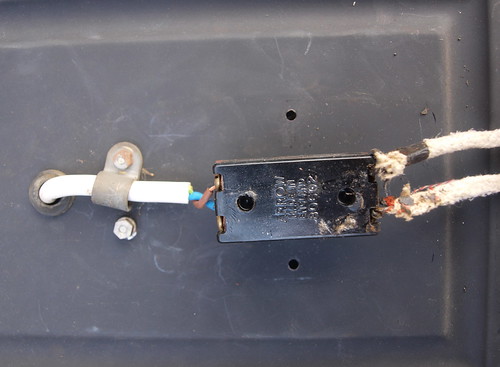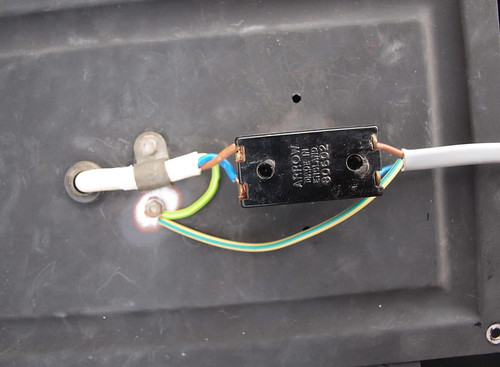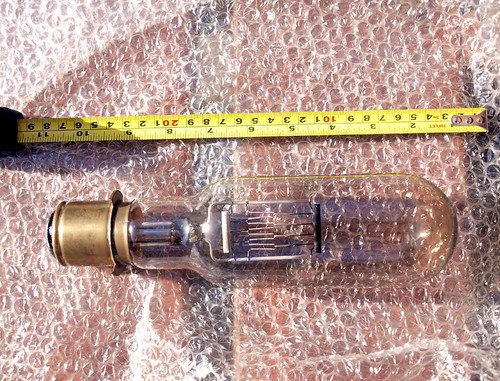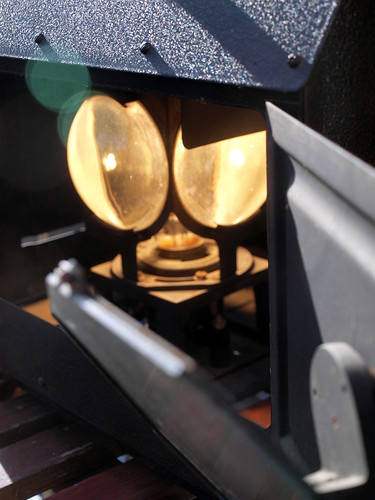So I have carefully looked over the 'scope and gave it a clean and brush down. More or less everything was in order, including the bulb which on testing it with my multimeter looked like the filament is still good. It's time to try to get it going.
It isn't just a matter of plugging it in. For one, the flex had been cut to the side of the 'scope and there was no plug. But more importantly the internal wires need checking over, are probably not safe, and probably need replacing. Especially on an old metal object such as this. As a minimum requirement, metal appliances need earth connections, which were not normally fitted in the "good old days", and should be fused properly too.
Earth
Apologies to people who know all this, but I will say it anyway. "Earth" is the third wire in the mains plug and is an important safety feature on appliances that are metal. The problem is that, without earth, all too often a wire gets frayed or damaged and accidentally gets out of place. Usually it falls onto or otherwise ends up touching metal somewhere, such as the metal of the case, or something connected electrically to the outside of the object. So anyone coming along who picks it up gets electrocuted. The solution is to wire the metal parts that people might touch to "earth", then if a wire gets frayed and loose it makes a connection to the metal, which is also connected to earth, so a short circuit occurs. This is still dangerous without fuses, but if fuses are fitted properly they blow on a short circuit, and the appliance fails, but at least it fails safely.
This old electrical appliance, like most old appliances, suffered two problems: no earth connection and very badly frayed electrical cable. In other words it was not safe. Here is the wire behind the main switch.

The switch itself is metal and electrically connected to the case, so in the event of a wiring failure, touching the switch would be very dangerous.
So the wire needs replacing, earth connections need to be made, and the appliance must be run from an adequately fused line. (The British system is to have a fuse in the plug at the right rating for the appliance, as well as circuit breakers on the system at the distribution box.)
Wiring is not rocket science. You must assess what current will flow and whether the wire will heat up or not. Actually, all wire heats up slightly when used, but often not very much. Hot wire has higher resistance and resistance makes wire get hotter. So when wire gets hot, it heats up more quickly still. This can "snowball" (an unfortunate phrase in this context) into a fire. For my item, I expect that the bulb will get hot - but the wiring is not near the bulb, it is away from it and in the cooler area below the bulb. The internal case is large with a decent volume of air and there is also a fan. So heat is not a major problem. The bulb is rated as 1000W from a 240V supply so we expect 1000/240 or about 4 amps to flow. Play safe and make sure all the wiring and connectors are rated at at least 5 amps. (I used stuff I had in my shed that was good for 13 amps.) The fuse should be 5 amps, not the common 13 amp ones.
Apart from that, it's just a matter or replacing the old wire with the new, and making earth connections to the metal case in strategic places (i.e. electrically connected to any metal the user might touch, but hidden from sight as far as possible.) Here is the re-wired switch.

I tested the wiring with my multimeter. I was also pleased to find that the switch switches both the live and neutral wires. (A useful safety feature in case that someone accidentally swapped over up live and neutral somewhere in the house's electrics.)
First light
The bulb in this projector is good sized 1000W tungsten filament lamp with a P40s connector. It is very delicate and was removed in advance of all the other work, so it's time to put it back and try everything out.

I was lucky, and it worked first time!

But even 1000W is not very impressive in full sunlight... I must try it at night time next, and with some slides.
Hi,
ReplyDeleteI would love to see an update of this project. I have been working on a similar project, upgrading a Beseler Slide King projector. I rewired everything and also grounded the projector. Mine came with a working 500 W bulb, but I replaced it with a 750 W bulb (all new electrical components are rated at 15 amps). It's quite nice and bright now, but the original lens was not so great... I stuck a Schneider Kreuznach lens on it, which is still made for the Goetschmann projectors. Fantastic lens, 250mm f/4.0. I wish I had the 150mm f/2.8 though, which would fit my room better, but they are not cheap...
My projector uses the same bulbs as yours. You should be able to put a Halogen bulb into yours. One that fits and has the filament at the correct position is the "Philips 500W 120V BTL P28s". I will try one next week, mostly out of curiousity.
My biggest concern at the moment is ventilation. The projector and lamp seem to be fine, but the slides show some very slight warping if they are displayed for longer (e.g. 5 minutes). Even if they are glass-mounted. I am planning on somehow adding a crossflow fan right next to the slide holder, and replace the stock fan with a better one.
Let me hear more of your Epidiascope :)